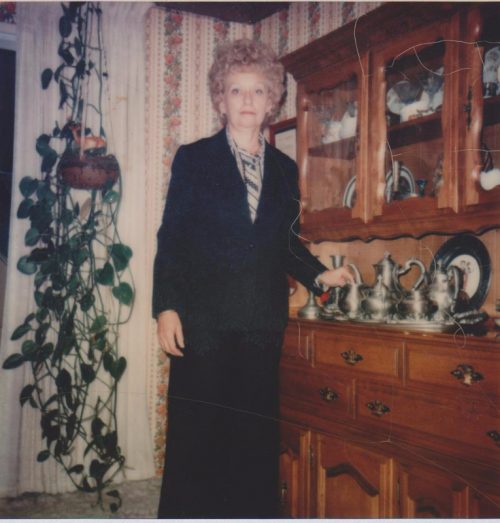
.
Susan appears agonal and preterminal.
From a neurological consult report dated September 18, 1979,
11 days before she dies.
I have to look up agonal.
Of or related to great pain.
As in the agony of death.
She was in pain.
I never thought about her being in pain.
Her long hospital records indicate her primary problem began with seizures in 1961.
A malignant glioma in the left temporal area, excised
surgically in January 1961 at the Mayo Clinic.
Rochester, Minnesota. Then, radiation. She is 11 years old,
my big sister by 10 years. I am the baby of the family.
Mother calls it “cobalt treatment.” Old black and white
zig-zag-edged photos from Rochester, before the treatment,
show Susie, grinning maniacally from behind a monstrous
snowbank and lobbing snowballs toward the camera.
We live in a small ivy-green bungalow in a new subdivision
in Sunny San Diego. Three white birchbark willows
congregate in a curved brick bed by the driveway.
I pedal my purple stingray with its glittery banana seat
and tassels to May Scott Marcy Elementary School.
Except for Susie, we are like everyone else.
She has grand mal seizures. We call them spells.
When she has a spell, we say, “Mother, Susie!”
Mother comes and strokes Susie’s brow
until the seizure passes. She kneels
and cradles Susie’s head in her lap.
This happens daily and everywhere.
In the checkout line at FedMart,
while Mother is waiting to pay, Susie
careens sideways and crumples. Fat faces
stare and I stare back until they look away.
Susie is unpredictable and often violent.
Plates and glasses are thrown. Squad cars
in the driveway are not uncommon.
Sedatives and syringes sleep in the fridge.
Mrs. Foster, the nurse who lives up the street,
comes to stick Susie when necessary.
Mother bakes a German chocolate cake for her
and dispatches me up Mott Street with it.
Rose Canyon slumps behind the house
with its iceplant, tumbleweeds and wild mustard.
While I’m in the backyard, playing horses,
there’s a ruckus indoors.
Susie is howling something
that sounds like “kill me, kill me.”
She is held down on the bed
by Mother, Daddy, Stephanie, Doug,
each with a limb.
This scene does not involve me.
I’m not even sure that I actually see it.
In private, Stephanie and I play a game
of making fun of Susie. I pretend to be Susie.
I knock on the bedroom door and say,
“Stephanie, Mother says you have to come
and get into the … dog.” I pretend that I can’t
remember the word for car. This makes us roar.
 Sister Stephanie and Sharon, 4 and 7
Sister Stephanie and Sharon, 4 and 7
1969, Mesa Vista hospital for “acute psychosis.”
Hydrocephalus. Pressure on the brain.
Susie is rolled in an old green army blanket
to immobilize her during one of her rages.
She is deposited on the Chevy wagon’s
middle seat to be driven to the hospital.
Daddy stands in the garage beside the car
and he is weeping.
1972, a low pressure ventricularperitoneal
shunt to drain the fluid. An infection.
The shunt requires replacement later that year.
1973, a neurilemmoma. Craniotomy.
After that, she is mute. A “neurologic cripple.”
We have a van with an hydraulic lift.
Mother ties Susie into the wheelchair
and drives to Del Taco where Mother
has a floury quesadilla and coffee with cream
in a styrofoam cup, which she drinks
in the parking lot next to the Subaru dealership.
The ridiculous sun is always shining.
Past history. Refer to old chart.
Permanent tracheostomy and gastrostomy.
Mother pumps formula into the stomach tube.
1976, Susie is hospitalized yet again
for “abdominal distention and regurgitation.”
Mother pumps food into Susie
and then Susie vomits it.
Medications: Diamox, Dilantin, Mysoline, Potassium Chloride and other medications as per her mother’s attached list. Family History: Noncontributory. Review of Systems: Noncontributory.
Agonal. She is in pain.
For years and years, pain.
Strapped upright in the wheelchair,
parked in front of the living room’s
console TV for The Wheel of Fortune,
eyes lolling, she is in pain.
She has been cared for at home by her mother, with some occasional assistance from night nurses. This admission was prompted when she seemed to be “going downhill,” according to the mother. She has had temperature, been less responsive, and has not urinated normally. In addition, she has been agitated and combative.
Her inhuman utterances,
the mouth crooked, saliva stringing.
Urine in the sofa, in the wheelchair,
in the canopied princess bed in the bedroom
across the hall from my room
where I stay up late late to watch
Johnny Carson, Tom Snyder.
The suction machine thumps and squalls.
If the trach tube is not cleared, Susie will suffocate.
Imagine a metallic hole in your trachea.
Now, a thin plastic tube going in, sucking.
I only think about how noisy it is.
The patient is unable to aid in any self-care.
Mother sleeps with her. Twin beds.
Daddy sleeps in the den as he always has.
Mother naps in the afternoon, when she can.
I see her sitting on the bed’s edge, as if
she has just woken up, her head hanging.
The house smells like pee and shit.
The floral sofa is particularly redolent.
Sometimes there’s an ambulance
in the driveway, red lights strobing.
I never think about her being in pain.
Mother bends Susie’s arms and legs twice
daily in the room with the mirrored closet doors.
Sometimes Susie makes noises.
I do not think of them as moans.
It’s just Susie.
The patient has always been in the same mental state, virtually comatose, since I have been seeing her. However, the mother continues to notice changes in the level of consciousness, noting that sometimes for periods of weeks to months she will respond, watch television, smile, and Mrs. McCartney notes that Susan has actually said several short sentences. Nonetheless, none of those have ever been witnessed by any of the medical profession and there is some question as to whether the changes are perceived to be greater by the mother than they are.
 Mother
Mother
Mother will not put Susie in a nursing home.
Mother says, “She would be dead in a day!”
No one ever talks about it,
what has happened to our family.
She has urinary tract infections,
pneumonia, low grade fevers.
Eventually, an indwelling catheter.
I never think about her pain,
her real physical pain.
For years I have regarded her as being in a persistent akinetic, mute or vegetative state secondary to her multiple brain tumors, shunt and general debility…. It would appear to this examiner that the combination of nonreactive pupils and absent doll’s eyes, unresponsiveness, and respiratory depression can all be related to progressive central nervous system deterioration because of the effects of the numerous central nervous system insults to this poor girl.
This poor girl. No one in the family says that.
When I run away from home,
to the beach, and am returned
24 hours later by the police,
Mother chooses to converse with me
about my tribulations while washing
Susie. Arms, legs, genitalia.
I stare into the closet’s mirrored doors.
I can see Susie behind me, naked and inert.
I realize that Mother is making A Point,
but I will not bow down.
We are stubborn.
1961, the doctors say Susie will not last
another six months, but she does.
1994, Mother, in mortal pain herself,
on a morphine pump, refuses to die
until Lupe, the hospice nurse, scolds her:
“Gladys, it’s time for you to go.
Susan is waiting for you.” Mother dies.
Is there any value in exploring this?
Whatever you deny grows stronger.
Go there. Stop avoiding it.
Stop pretending it didn’t happen.
Her prostration, slack hair, flaccid arms.
Mother heaving that thin, collapsed body
onto a fresh Chux. The cyanotic limbs.
She was in pain. Imagine any one
of your children in pain. For years.
Diagnoses:
1. Occlusion distal valve of ventriculoperitoneal shunt.
2. Normal pressure hydrocephalus, controlled.
3. Grand mal epilepsy, controlled.
4. Status postoperative posterior fossa brain tumor, neurilemmoma (1973).
5. Status postoperative left temporal glioma (1961).
6. Feeding gastrostomy tube in place (1973).
7. Permanent tracheotomy in place (1973).
8. Status postoperative laparotomy for bowel obstruction (4-3-76).
9. Status postoperative scalp debridement for wound dehiscence over shunt tube (4-8-76).
Mother is a martyr, but she’s not a hero.
She gets tired and bitter and morose.
When Daddy buys a motorboat (his business
is doing well) and names it the Susie-Q,
Mother sneers, “He would buy her anything.
He would put a pool in the yard if she wanted it.”
I want a pool. I would love to have a pool.
It was Dr. DeBolt’s feeling, with which I concur, that there has been progressive CNS deterioration, from her already low level function over the past several months and that it was not unlikely that this was a central fever. In any event, it seems clear that no further medical work-up is likely to be helpful…. There was a long discussion with both Mr. and Mrs. McCartney by myself as well as by Dr. DeBolt regarding heroic measures and it was felt that because of Susan’s general condition, resuscitation should not be undertaken.
Susie dies on September 29, 1979.
Daddy is with her when it happens. After,
he waits at the hospital’s front doors to tell Mother.
Mother says, “Thank God it’s over.”
And walks back to her car.
I am away at college, but Daddy phones me
with the news. My knees goes weak.
I have to sit down. I’m thinking,
“Wow, that actually happens.”
I thought it was just a cliché.
There is a funeral, but Mother does not attend.
I come home for a visit at Christmas,
the first Christmas after Susie’s death.
I bring my laundry and Mother does it for me.
When the dryer is finished, she dumps
the clean clothes in Susie’s wheelchair
and trudges it down the hallway
to the mirrored bedroom where she irons
and folds and irons and folds.
—Sharon McCartney
.
Sharon McCartney is the author of Metanoia (Biblioasis, 2016), which appeared originally in its entirety in Numéro Cinq, and five other collections of poetry: Hard Ass (Palimpsest, 2013), For and Against (Goose Lane Editions, 2010), The Love Song of Laura Ingalls Wilder (Nightwood, 2007), Karenin Sings the Blues (Goose Lane Editions, 2003), and Under the Abdominal Wall (Anvil Press, 1999). She is a graduate of the Iowa Writers’ Workshop, the University of Victoria’s Faculty of Law, and Pomona College.
.
Wow. Stunning.
Thank you, Colette.
That is powerful – must have been hard. Well done.
Thank you, Ann.
Coincidental or not, the timing of this rings hard as the Senate debates and death, assisted or otherwise, is in an awkward limbo.
Thanks Sharon for sharing this via a warm place of sorts. Doesn’t mean it’s comfortable. Not cruel.
sigh
Thank you, John.